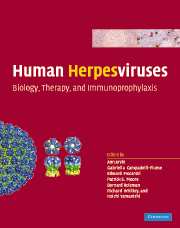Book contents
- Frontmatter
- Contents
- List of contributors
- Preface
- Part I Introduction: definition and classification of the human herpesviruses
- Part II Basic virology and viral gene effects on host cell functions: alphaherpesviruses
- Part II Basic virology and viral gene effects on host cell functions: betaherpesviruses
- Part II Basic virology and viral gene effects on host cell functions: gammaherpesviruses
- Part III Pathogenesis, clinical disease, host response, and epidemiology: HSV-1 and HSV-2
- Part III Pathogenesis, clinical disease, host response, and epidemiology: VZU
- Part III Pathogenesis, clinical disease, host response, and epidemiology: HCMV
- Part III Pathogenesis, clinical disease, host response, and epidemiology: HHV- 6A, 6B, and 7
- 46 HHV-6A, 6B, and 7: pathogenesis, host response, and clinical disease
- 47 HHV-6A, 6B, and 7: molecular basis of latency and reactivation
- 48 HHV-6A, 6B, and 7: immunobiology and host response
- 49 HHV-6A, 6B, and 7: persistence in the population: epidemiology and transmission
- Part III Pathogenesis, clinical disease, host response, and epidemiology: gammaherpesviruses
- Part IV Non-human primate herpesviruses
- Part V Subversion of adaptive immunity
- Part VI Antiviral therapy
- Part VII Vaccines and immunothgerapy
- Part VIII Herpes as therapeutic agents
- Index
- Plate section
- References
49 - HHV-6A, 6B, and 7: persistence in the population: epidemiology and transmission
from Part III - Pathogenesis, clinical disease, host response, and epidemiology: HHV- 6A, 6B, and 7
Published online by Cambridge University Press: 24 December 2009
- Frontmatter
- Contents
- List of contributors
- Preface
- Part I Introduction: definition and classification of the human herpesviruses
- Part II Basic virology and viral gene effects on host cell functions: alphaherpesviruses
- Part II Basic virology and viral gene effects on host cell functions: betaherpesviruses
- Part II Basic virology and viral gene effects on host cell functions: gammaherpesviruses
- Part III Pathogenesis, clinical disease, host response, and epidemiology: HSV-1 and HSV-2
- Part III Pathogenesis, clinical disease, host response, and epidemiology: VZU
- Part III Pathogenesis, clinical disease, host response, and epidemiology: HCMV
- Part III Pathogenesis, clinical disease, host response, and epidemiology: HHV- 6A, 6B, and 7
- 46 HHV-6A, 6B, and 7: pathogenesis, host response, and clinical disease
- 47 HHV-6A, 6B, and 7: molecular basis of latency and reactivation
- 48 HHV-6A, 6B, and 7: immunobiology and host response
- 49 HHV-6A, 6B, and 7: persistence in the population: epidemiology and transmission
- Part III Pathogenesis, clinical disease, host response, and epidemiology: gammaherpesviruses
- Part IV Non-human primate herpesviruses
- Part V Subversion of adaptive immunity
- Part VI Antiviral therapy
- Part VII Vaccines and immunothgerapy
- Part VIII Herpes as therapeutic agents
- Index
- Plate section
- References
Summary
Introduction
In common with all human herpesviruses, HHV-6 and HHV-7 establish lifelong infection following initial exposure and seroconversion. True latency as exemplified by HSV-1 and VZV, in which the genome is maintained in a transcriptionally restricted state, has not been conclusively shown for HHV-6 or HHV-7. However, the betaherpesviruses may persist in individuals via low grade replication which is continuously suppressed by a functional immune response. In this chapter we will summarize the current understanding of the epidemiology and persistence of HHV-6 and HHV-7 in the human host and its relevance to transmission. In addition, we will highlight a novel form of persistence for HHV-6 which involves integration into host chromosomal DNA.
Persistence of HHV-6 and HHV-7 in individuals
In the case of both HHV-6 and HHV-7, PCR analysis of peripheral blood mononuclear cells (PBMC) shows that a sensitive nested assay and an adequate quantity of input DNA (at least equivalent to approximately 150000 mononuclear cells or 1μg DNA) can detect viral DNA in healthy immunocompetent individuals suggestive of low levels of latent/persisting virus in peripheral blood (Jarrett et al., 1990; Clark et al., 1996; Kidd et al., 1996). In contrast, viral loads are maintained at high levels in saliva of seropositive individuals, particularly in the case of HHV-7 (Kidd et al., 1996; Fujiwara et al., 2000; see Fig. 49.1).
- Type
- Chapter
- Information
- Human HerpesvirusesBiology, Therapy, and Immunoprophylaxis, pp. 875 - 882Publisher: Cambridge University PressPrint publication year: 2007
References
- 10
- Cited by

